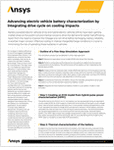 | An increase in battery efficiency is one of the biggest challenges that engineers face. While Li-ion batteries are currently the best option available, they are by no means the ultimate in battery technology: There is much room for improvement. The high mass of Li-ion batteries reduces fuel efficiency in automobiles, and their potential flammability makes them dangerous, particularly in the event of a crash. Researchers worldwide are trying to develop a better battery to replace Li-ion technology. For now, optimizing the configuration of Li-ion batteries is the best method of increasing battery performance, but batteries are complex systems that are difficult to model and test using physical prototypes. Numerical simulation is an indispensable tool for battery designers and researchers. Since the battery is a multiphysics application, its simulation involves many different disciplines, including, but not limited to, electrochemical modeling, electrical circuit modeling, electromagnetics modeling and thermal modeling. Here we present one method of using engineering simulation solutions to optimize battery performance and function by comparing different numerical approaches. Request Free! |
